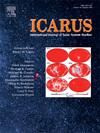An analogue study of impact craters on Titan: Implications for Titan's surface age
IF 2.5
2区 物理与天体物理
Q2 ASTRONOMY & ASTROPHYSICS
引用次数: 0
Abstract
Titan is the only planetary body in our solar system, besides Earth, that has stable liquids on its surface and a thick, nitrogen-rich atmosphere. NASA's Cassini mission detected an unusually low number of impact craters on Titan's surface, possibly due to degradation and burial by fluvial erosion and aeolian infilling. This is similar to the reduced number of craters seen on Earth, which is a result of both endogenic and exogenic processes, like erosion and weathering. Given these similarities, Earth serves as a strong analogue for studying the preservation of Titan's craters. There are 200 confirmed craters on Earth, of which 67 are buried and therefore unobservable from orbit. This study determines the percentage of the remaining exposed and resolvable terrestrial craters that can be identified in synthetic aperture radar data (SAR), in order to estimate the number of craters we may be missing in Cassini RADAR images of Titan. The results show that only ∼60 % of the non-buried terrestrial craters are distinctly visible in radar images; the remaining 40 % were not clearly identified by the authors. These findings were further validated through a crowd-sourcing exercise, where users attempted to identify craters in a smaller sample of radar images. If a similar number of craters are obscured on Titan, it suggests that 40 % of Titan's non-buried craters are not visible in the Cassini RADAR data set. Thus, the surface age of Titan could be ∼1.5-2× older (∼300 Ma – 2 Ga) than currently hypothesized (∼200 Ma – 1 Ga).
求助全文
约1分钟内获得全文
求助全文
来源期刊

Icarus
地学天文-天文与天体物理
CiteScore
6.30
自引率
18.80%
发文量
356
审稿时长
2-4 weeks
期刊介绍:
Icarus is devoted to the publication of original contributions in the field of Solar System studies. Manuscripts reporting the results of new research - observational, experimental, or theoretical - concerning the astronomy, geology, meteorology, physics, chemistry, biology, and other scientific aspects of our Solar System or extrasolar systems are welcome. The journal generally does not publish papers devoted exclusively to the Sun, the Earth, celestial mechanics, meteoritics, or astrophysics. Icarus does not publish papers that provide "improved" versions of Bode''s law, or other numerical relations, without a sound physical basis. Icarus does not publish meeting announcements or general notices. Reviews, historical papers, and manuscripts describing spacecraft instrumentation may be considered, but only with prior approval of the editor. An entire issue of the journal is occasionally devoted to a single subject, usually arising from a conference on the same topic. The language of publication is English. American or British usage is accepted, but not a mixture of these.
 求助内容:
求助内容: 应助结果提醒方式:
应助结果提醒方式:


